A Modified Variable Power Angle Control for Unified Power Quality Conditioner in a Distorted Utility Source
Abstract
:1. Introduction
- For the control of UPQC, the use of SWFA in the harmonic voltage extraction process is presented. The use of multiple filters and design complexity are not required in this proposed approach.
2. Structure of the Studied Unified Power Quality Conditioner System
3. Harmonic Identification and Reference Signal Generation
3.1. Variable Power Angle Calculation
3.2. Sliding Window with Fourier Analysis Filter
3.3. Reference Voltage Signal Generation for Series Active Power Filter
3.4. Reference Current Signal Generation for Shunt Active Power Filter
4. Processor-in-the-Loop (PIL) Simulation
4.1. Processor-in-the-Loop Setup
4.2. Test Scenarios
- Load Change—two stages of load changes. Firstly, an increase in the reactive power demand by switching to load (L2). Secondly, a nonlinear load (L3) was connected, resulting in a 25.3%THD of the load current.
- Voltage Sag—a decrease in supply voltage magnitude by 20%.
- Voltage Swell—an increase in supply voltage magnitude by 20%.
- Harmonic Voltage—20V of the 5th harmonics and 20V of the 7th harmonics are added to the source voltage, resulting in a 9.09%THD of the source voltage.
4.3. Performance Evaluation
5. Results and Discussion
5.1. Filter Performance
5.2. Unified Power Quality Conditioner Performance
5.2.1. Load Changes
5.2.2. Supply Disturbances
5.3. Power Flow Analysis
5.3.1. Active Power
5.3.2. Reactive Power
6. Conclusions
Author Contributions
Funding
Data Availability Statement
Conflicts of Interest
References
- Zanib, N.; Batool, M.; Riaz, S.; Nawaz, F. Performance Analysis of Renewable Energy Based Distributed Generation System Using ANN Tuned UPQC. IEEE Access 2022, 10, 110034–110049. [Google Scholar] [CrossRef]
- Gomez, Y.A.G.; García, N.T.; Hoyos, F.E. New Application’s Approach to Unified Power Quality Conditioners for Mitigation of Surge Voltages. J. Electr. Comput. Eng. 2016, 6384390. [Google Scholar] [CrossRef]
- Brumsickle, W.E.; Schneider, R.S.; Luckjiff, G.; Divan, D.; McGranaghan, M. Dynamic sag correctors: Cost-effective industrial power line conditioning. IEEE Trans. Ind. Appl. 2001, 37, 212–217. [Google Scholar] [CrossRef]
- Ghorbani, M.; Mokhtari, H. Impact of harmonics on power quality and losses in power distribution systems. Int. J. Electr. Comput. Eng. 2015, 5, 166–174. [Google Scholar] [CrossRef]
- Prasad, D.; Dhanamjayulu, C. A Review of Control Techniques and Energy Storage for Inverter-Based Dynamic Voltage Restorer in Grid-Integrated Renewable Sources. Math. Probl. Eng. 2022, 6389132. [Google Scholar] [CrossRef]
- Mohammed, B.S.; Rao, K.S.; Ibrahim, R.; Perumal, N. Performance evaluation of R-UPQC and L-UPQC based on a novel voltage detection algorithm. In Proceedings of the 2012 IEEE Symposium on Industrial Electronics and Applications, Bandung, Indonesia, 23–26 September 2012. [Google Scholar] [CrossRef]
- Beres, R.N.; Wang, X.F.; Liserre, M.; Blaabjerg, F.; Bak, C.L. A Review of Passive Power Filters for Three-Phase Grid-Connected Voltage-Source Converters. IEEE J. Emerg. Sel. Top. Power Electron. 2016, 4, 54–69. [Google Scholar] [CrossRef]
- Li, J.W.; Tang, Y.F.; Li, J.K. Research on Adaptive Suppression of LCL Converter Resonance Grid-Connected System. J. Electr. Comput. Eng. 2020, 1959073. [Google Scholar] [CrossRef]
- Singh, B.; Al-Haddad, K.; Chandra, A. A review of active filters for power quality improvement. IEEE Trans. Ind. Electron. 1999, 46, 960–971. [Google Scholar] [CrossRef]
- Fujita, H.; Akagi, H. The unified power quality conditioner: The integration of series- and shunt-active filters. IEEE Trans. Power Electron. 1998, 13, 315–322. [Google Scholar] [CrossRef]
- Khadkikar, V.; Chandra, A.; Barry, A.O.; Nguyen, T.D. Conceptual study of unified power quality conditioner (UPQC). In Proceedings of the 2006 IEEE International Symposium on Industrial Electronics, Montreal, QC, Canada, 9–13 July 2006; Volume 1–7, pp. 1088–1093. [Google Scholar] [CrossRef]
- Lee, W.C.; Lee, D.M.; Lee, T.K. New Control Scheme for a Unified Power-Quality Compensator-Q with Minimum Active Power Injection. IEEE Trans. Power Deliv. 2010, 25, 1068–1076. [Google Scholar] [CrossRef]
- Basu, M.; Das, S.P.; Dubey, G.K. Performance study of UPQC-Q for load compensation and voltage sag mitigation. In Proceedings of the IEEE 2002 28th Annual Conference of the Industrial Electronics Society, Seville, Spain, 5–8 November 2002; pp. 698–703. [Google Scholar]
- Kolhatkar, Y.Y.; Das, S.P. Experimental investigation of a single-phase UPQC with minimum VA loading. IEEE Trans. Power Deliv. 2007, 22, 373–380. [Google Scholar] [CrossRef]
- Kolhatkar, Y.Y.; Errabelli, R.R.; Das, S.P. A sliding mode controller based optimum UPQC with minimum VA loading. In Proceedings of the IEEE Power Engineering Society General Meeting, San Francisco, CA, USA, 16 June 2005; pp. 871–875. [Google Scholar]
- Khadkikar, V.; Chandra, A. A new control philosophy for a unified power quality conditioner (UPQC) to coordinate load-reactive power demand between shunt and series inverters. IEEE Trans. Power Deliv. 2008, 23, 2522–2534. [Google Scholar] [CrossRef]
- Khadkikar, V.; Chandra, A. UPQC-S: A Novel Concept of Simultaneous Voltage Sag/Swell and Load Reactive Power Compensations Utilizing Series Inverter of UPQC. IEEE Trans. Power Electr. 2011, 26, 2414–2425. [Google Scholar] [CrossRef]
- Khadkikar, V. Fixed and variable power angle control methods for unified power quality conditioner: Operation, control and impact assessment on shunt and series inverter kVA loadings. IET Power Electron. 2013, 6, 1299–1307. [Google Scholar] [CrossRef]
- Forghani, M.; Afsharnia, S. Online Wavelet Transform-Based Control Strategy for UPQC Control System. IEEE Trans. Power Deliv. 2007, 22, 481–491. [Google Scholar] [CrossRef]
- Ye, J.; Gooi, H.B.; Wu, F.J. Optimal Design and Control Implementation of UPQC Based on Variable Phase Angle Control Method. IEEE Trans. Ind. Inform. 2018, 14, 3109–3123. [Google Scholar] [CrossRef]
- Devassy, S.; Singh, B. Modified -Theory-Based Control of Solar-PV-Integrated UPQC-S. IEEE Trans. Ind. Appl. 2017, 53, 5031–5040. [Google Scholar] [CrossRef]
- Panda, A.K.; Patnaik, N. Management of reactive power sharing & power quality improvement with SRF-PAC based UPQC under unbalanced source voltage condition. Int. J. Electr. Power 2017, 84, 182–194. [Google Scholar] [CrossRef]
- Ni, F.Y.; Wo, S.L.; Li, Z.M. A Harmonic Detection Method of UPQC Based on LSL Algorithm in Photovoltaic Microgrids. J. Control Autom. Electr. 2020, 31, 1567–1575. [Google Scholar] [CrossRef]
- Arya, S.R.; Alam, S.J.; Ray, P. Control Algorithm Based on Limit Cycle Oscillator-FLL for UPQC-S with Optimized PI Gains. CSEE J. Power Energy 2020, 6, 649–661. [Google Scholar] [CrossRef]
- Jin, T.; Chen, Y.L.; Guo, J.T.; Wang, M.Q.; Mohamed, M.A. An effective compensation control strategy for power quality enhancement of unified power quality conditioner. Energy Rep. 2020, 6, 2167–2179. [Google Scholar] [CrossRef]
- Patnaik, N.; Panda, A.K. Performance analysis of a 3 phase 4 wire UPQC system based on PAC based SRF controller with real time digital simulation. Int. J. Electr. Power 2016, 74, 212–221. [Google Scholar] [CrossRef]
- Khadkikar, V.; Chandra, A.; Barry, A.O.; Nguyen, T.D. Application of UPQC to protect a sensitive load on a polluted distribution network. In Proceedings of the 2006 Power Engineering Society General Meeting, Montreal, QC, Canada, 18–22 June 2006; Volume 1–9, p. 15. [Google Scholar] [CrossRef]
- Kumar, G.S.; Kumar, B.K.; Mishra, M.K. Mitigation of Voltage Sags with Phase Jumps by UPQC with PSO-Based ANFIS. IEEE Trans. Power Deliv. 2011, 26, 2761–2773. [Google Scholar] [CrossRef]
- Santiprapan, P.; Areerak, K.; Areerak, K. A Novel Harmonic Identification Algorithm for the Active Power Filters in Non-Ideal Voltage Source Systems. J. Power Electron. 2017, 17, 1637–1649. [Google Scholar] [CrossRef]
- El-Habrouk, M.; Darwish, M. Design and implementation of a modified Fourier analysis harmonic current computation technique for power active filters using DSPs. IEE Proc. Electr. Power Appl. 2001, 148, 21. [Google Scholar] [CrossRef]
- IEEE Std. 519-2022; IEEE Standard for Harmonic Control in Electric Power Systems. IEEE: New York, NY, USA, 2022.
- ANSI C84.1-2016; American National Standard for Electric Power Systems and Equipment—Voltage Ratings (60 Hz). NEMA: Arlington, VA, USA, 2016.
- Narongrit, T.; Areerak, K.; Areerak, K. Adaptive Fuzzy Control for Shunt Active Power Filters. Electr. Power Compon. Syst. 2016, 44, 646–657. [Google Scholar] [CrossRef]
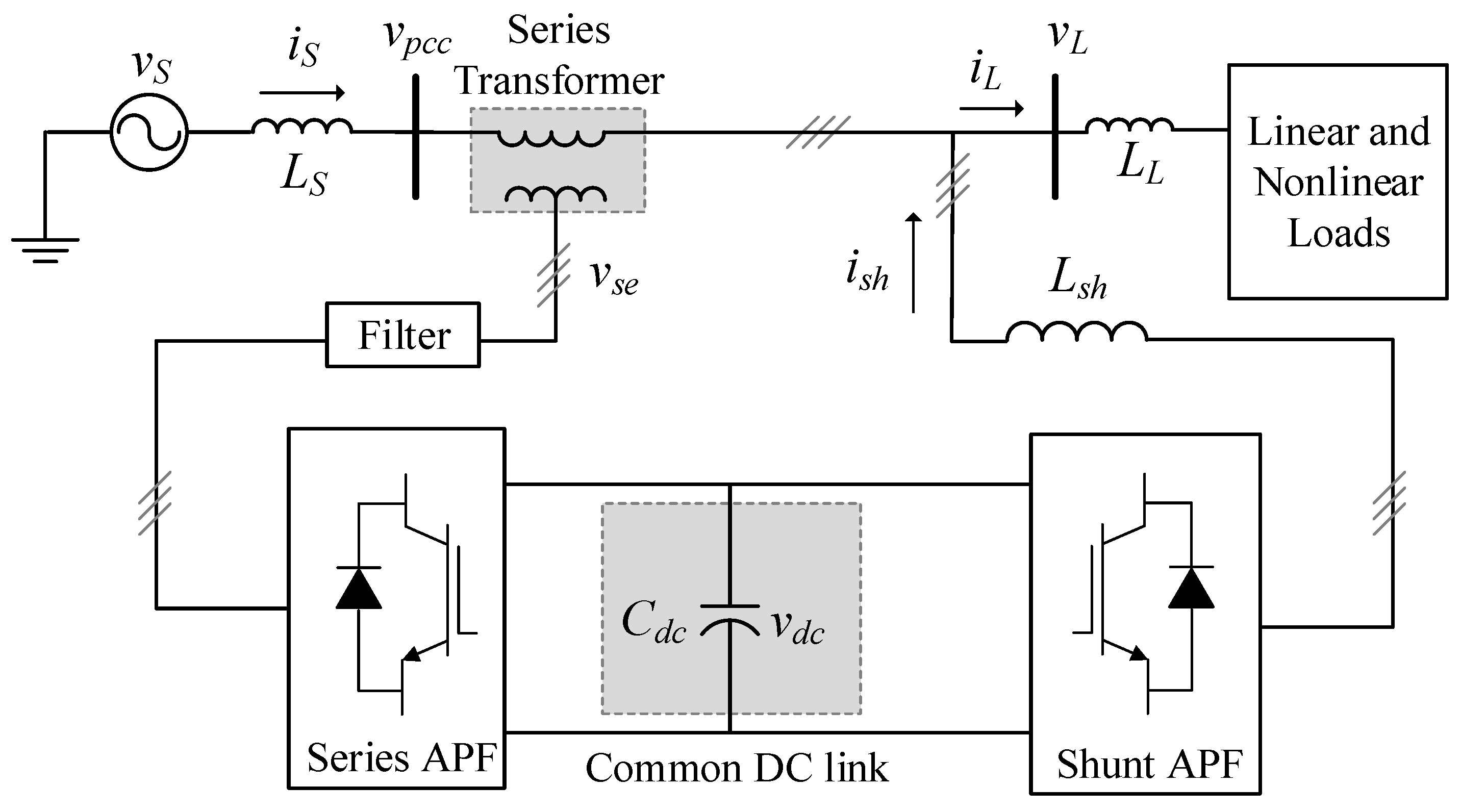
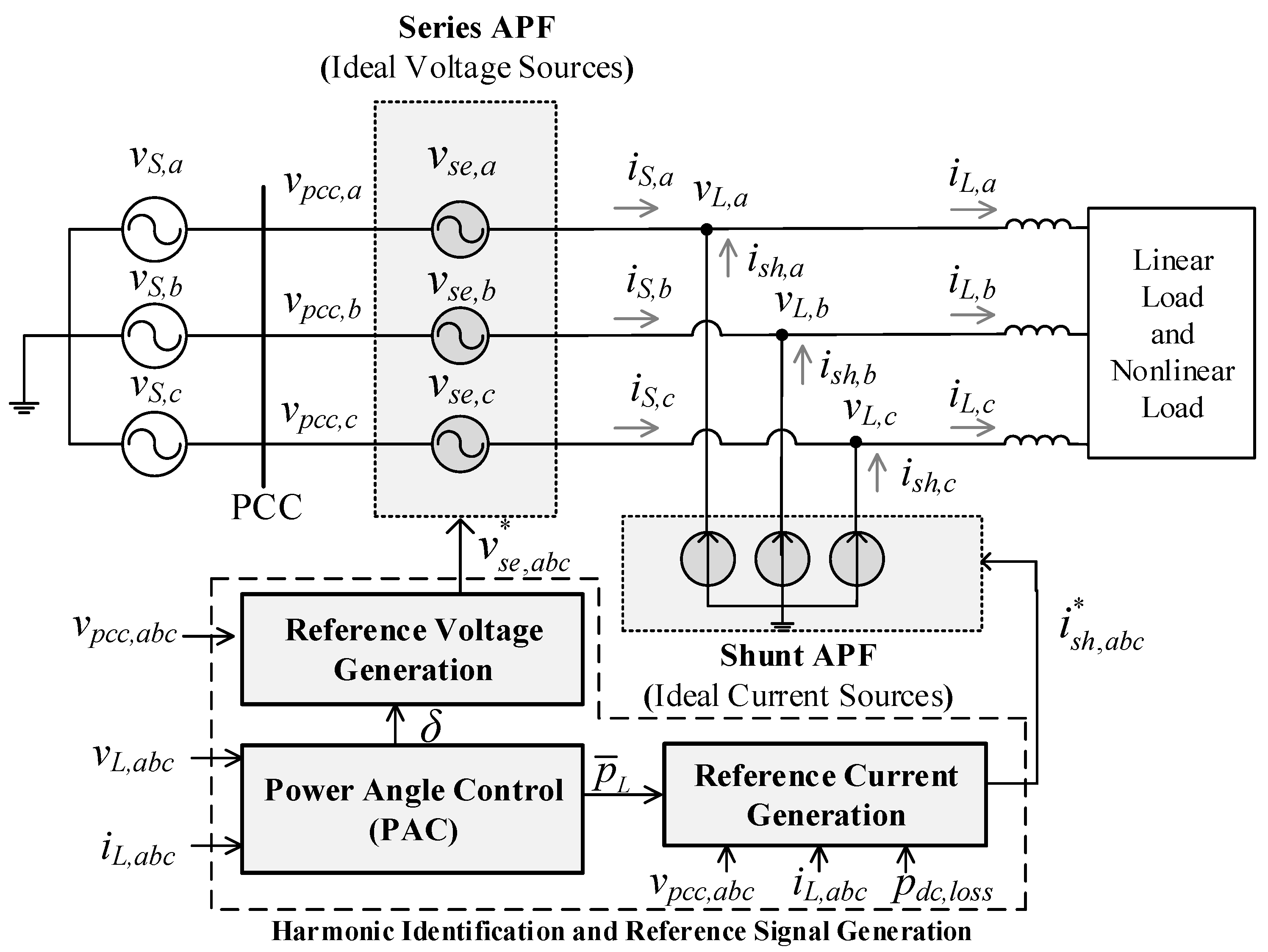
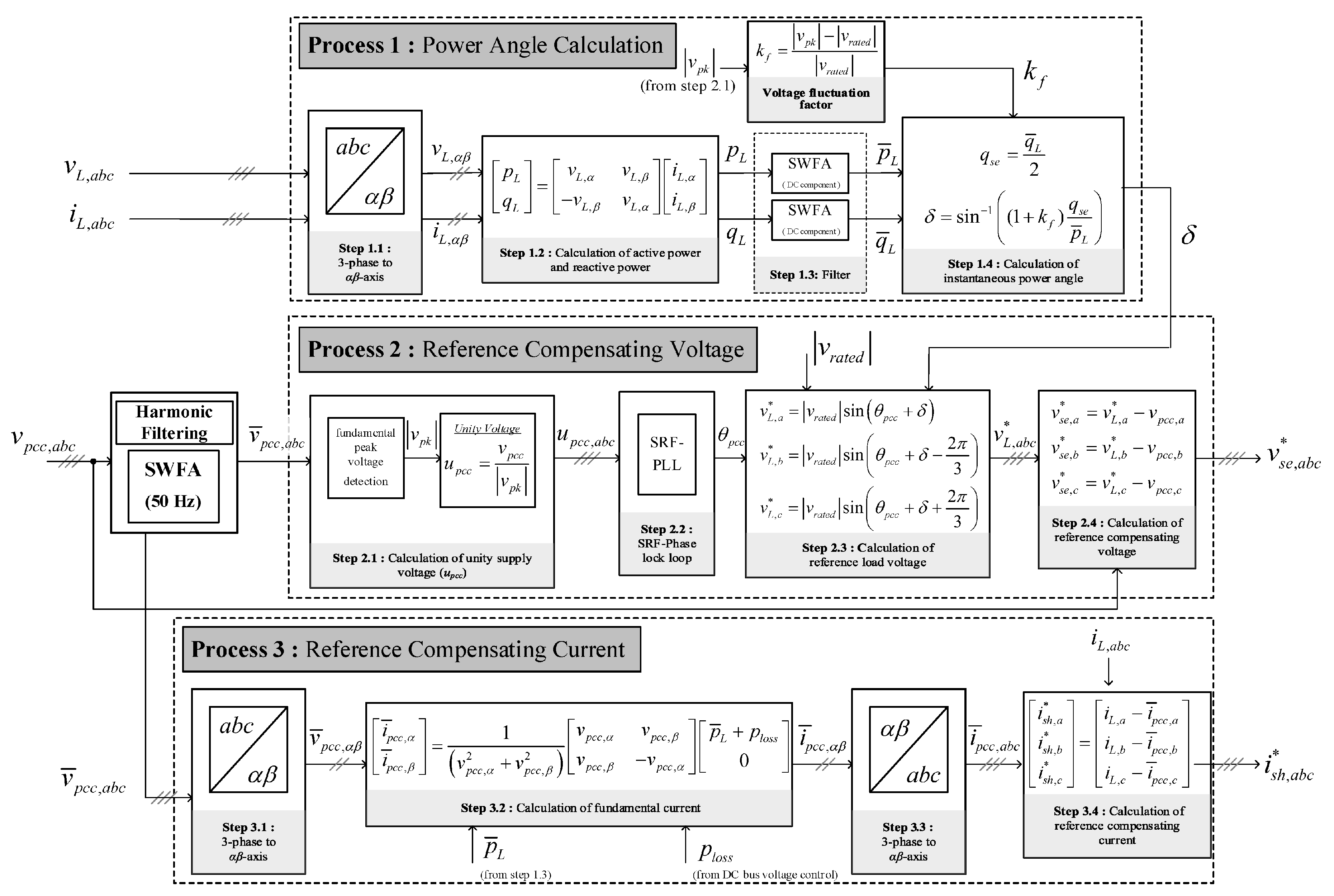
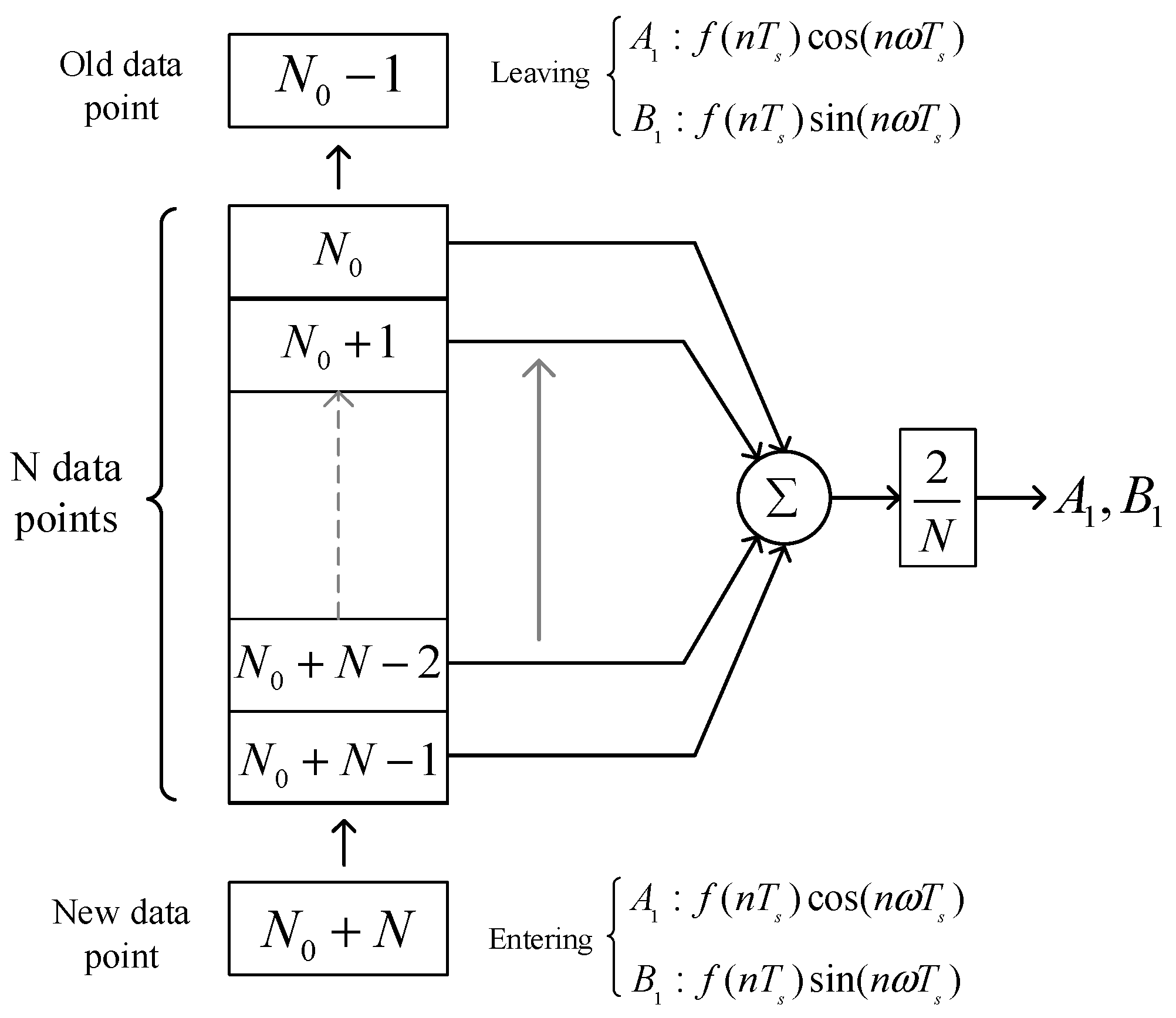




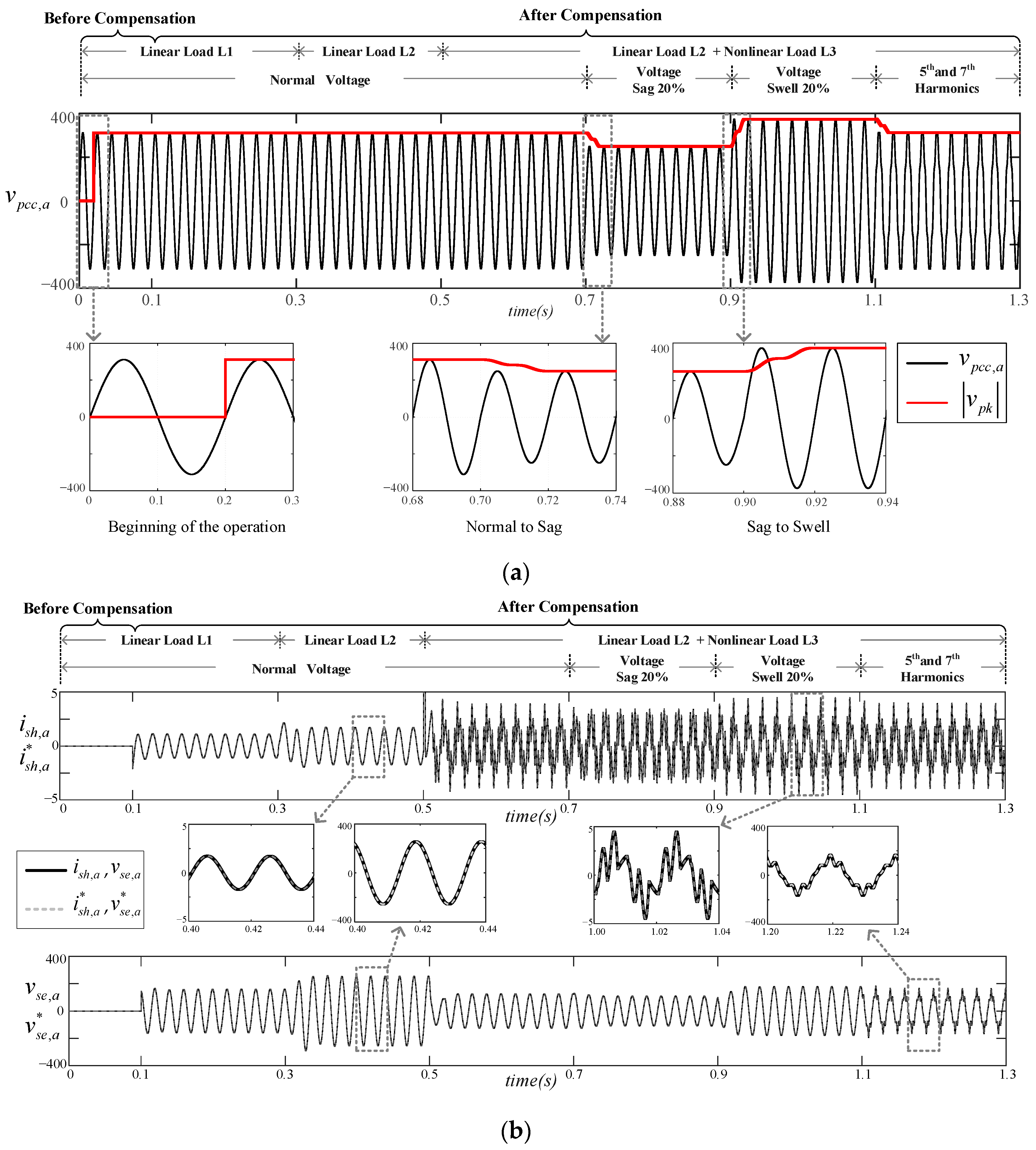



| Publication Year | Power System | Compensation Strategy | Harmonic Identification Method | Operating Conditions /Disturbances | Sharing of Load Reactive Power | ||
|---|---|---|---|---|---|---|---|
| Series APF | Shunt APF | Voltage Source | Load System | ||||
| 2007 [19] | 3P4W | proposed method | Discrete Wavelet Transform (DWT) and MRA | Discrete Wavelet Transform (DWT) and MRA |
|
| NO |
| 2008 [16] | 3P3W | UPQC-S | UVTG with PAC | Instantaneous pq theory |
|
| YES |
| 2011 [17] | 3P3W | UPQC-S | UVTG with PAC | Instantaneous pq theory |
|
| YES |
| 2011 [28] | 3P4W | UPQC-PSO based ANFIS | State Space Extraction | State Space Extraction |
|
| NO |
| 2015 [26] | 3P4W | UPQC-S | SRF theory | SRF theory |
|
| YES |
| 2017 [21] | 3-phase with PV | UPQC-S | UVTG with PAC | Instantaneous pq theory with GCDSC+BPF |
|
| YES |
| 2018 [20] | 3P3W | UPQC-S | Proposed controllable PAC | Instantaneous pq theory |
|
| YES |
| 2020 [23] | 3P3W | Not mentioned | Not mentioned | Proposed Adaptive LSL |
|
| NO |
| 2020 [25] | 3P3W | Not mentioned | SRF theory with LPF and PLL | Double closed-loop control based |
|
| NO |
| 2020 [24] | 3P3W | UPQC-S | Instantaneous pq theory with LCO-FLL | Instantaneous pq theory with LCO-FLL |
|
| YES |
| This work | 3P3W | UPQC-S | UVTG with variable PAC | Instantaneous pq theory with SWFA filtering |
|
| YES |
| Parameters | Value |
|---|---|
| Supply Voltage Frequency | vs = 380 VL-L, fs = 50 Hz |
| Line Impedance | LL = 10 mH |
| Linear Loads (L1, L2) | SL1 = 1 kW + j1kVar, SL2 = 1 kW + j1.5kVar |
| Nonlinear Load (L3) | Diode Bridge Rectifier with RL3 = 160 Ω, LL3 = 0.5 H, CL3 = 40 μF |
| Series APF | Ideal voltage sources |
| Shunt APF | Ideal current sources |
| Time (s) | Situations |
|---|---|
| 0–0.1 | Normal supply system connected to Load L1 |
| 0.1–0.3 | Shunt and Series APFs ON |
| 0.3–0.5 | Switch to Load L2 (L1 disconnected) |
| 0.5–0.7 | Nonlinear Load L3 added (Load = L2 + L3) |
| 0.7–0.9 | 20% Voltage Sag |
| 0.9–1.1 | 20% Voltage Swell |
| 1.1–1.3 | Harmonic Voltage |
| 140 | 207.54 | 4.23 |
| 160 | 210.29 | 4.64 |
| 180 | 212.27 | 5.01 |
| 200 | 213.69 | 5.35 |
| 220 | 214.75 | 5.67 |
| 240 | 215.60 | 5.95 |
| Case | Index | Load/Supply Situation | ||||||
|---|---|---|---|---|---|---|---|---|
| Normal Voltage | Normal Voltage | Voltage Sag | Voltage Swell | Harmonic Voltage | ||||
| L1 | L2 | L2 and L3 | ||||||
| Before Compensation | %THDv | 0.00 | 0.00 | 0.00 | 0.00 | 0.00 | 9.09 | |
| RMS | 220 | 220 | 220 | 176 | 264 | 220 | ||
| After Compensation | Without Filter [16] | %THDv | 0.00 | 0.00 | 0.00 | 0.00 | 0.00 | 3.67 |
| RMS | 221.1 | 221.6 | 220.9 | 220.6 | 221.3 | 220.7 | ||
| LPF (fc = 160 Hz) | %THDv | 0.02 | 0.05 | 0.00 | 0.00 | 0.00 | 1.67 | |
| RMS | 220.4 | 221.1 | 220.2 | 220 | 220.4 | 220.90 | ||
| With SWFA | %THDv | 0.03 | 0.04 | 0.00 | 0.01 | 0.00 | 0.55 | |
| RMS | 221.1 | 221.6 | 220.9 | 220.5 | 221.3 | 220.9 | ||
| Case | Index | Load/Supply Situation | ||||||
|---|---|---|---|---|---|---|---|---|
| Normal Voltage | Normal Voltage | Voltage Sag | Voltage Swell | Harmonic Voltage | ||||
| L1 | L2 | L2 and L3 | ||||||
| Before Compensation | %THDi | 0.00 | 0.00 | 25.31 | 25.31 | 25.31 | 22.16 | |
| RMS | 2.15 | 2.69 | 4.76 | 3.81 | 5.71 | 4.75 | ||
| Power Factor | 0.709 | 0.556 | 0.760 | 0.760 | 0.760 | 0.758 | ||
| After Compensation | Without Filter [16] | %THDi | 0.00 | 0.07 | 1.91 | 1.53 | 2.29 | 9.59 |
| RMS | 1.55 | 1.52 | 3.77 | 4.70 | 3.15 | 3.77 | ||
| LPF (fc = 160 Hz) | %THDi | 0.00 | 0.05 | 1.83 | 1.47 | 2.20 | 4.78 | |
| RMS | 1.61 | 1.58 | 3.92 | 4.89 | 3.27 | 3.93 | ||
| With SWFA | %THDi | 0.00 | 0.07 | 1.91 | 1.53 | 2.29 | 1.93 | |
| RMS | 1.55 | 1.52 | 3.77 | 4.70 | 3.15 | 3.76 | ||
| Power Factor | 1.00 | 0.999 | 0.999 | 0.999 | 0.999 | 0.996 | ||
Disclaimer/Publisher’s Note: The statements, opinions and data contained in all publications are solely those of the individual author(s) and contributor(s) and not of MDPI and/or the editor(s). MDPI and/or the editor(s) disclaim responsibility for any injury to people or property resulting from any ideas, methods, instructions or products referred to in the content. |
© 2024 by the authors. Licensee MDPI, Basel, Switzerland. This article is an open access article distributed under the terms and conditions of the Creative Commons Attribution (CC BY) license (https://creativecommons.org/licenses/by/4.0/).
Share and Cite
Chaiyaphun, K.; Santiprapan, P.; Areerak, K. A Modified Variable Power Angle Control for Unified Power Quality Conditioner in a Distorted Utility Source. Energies 2024, 17, 2830. https://doi.org/10.3390/en17122830
Chaiyaphun K, Santiprapan P, Areerak K. A Modified Variable Power Angle Control for Unified Power Quality Conditioner in a Distorted Utility Source. Energies. 2024; 17(12):2830. https://doi.org/10.3390/en17122830
Chicago/Turabian StyleChaiyaphun, Krittapas, Phonsit Santiprapan, and Kongpol Areerak. 2024. "A Modified Variable Power Angle Control for Unified Power Quality Conditioner in a Distorted Utility Source" Energies 17, no. 12: 2830. https://doi.org/10.3390/en17122830







